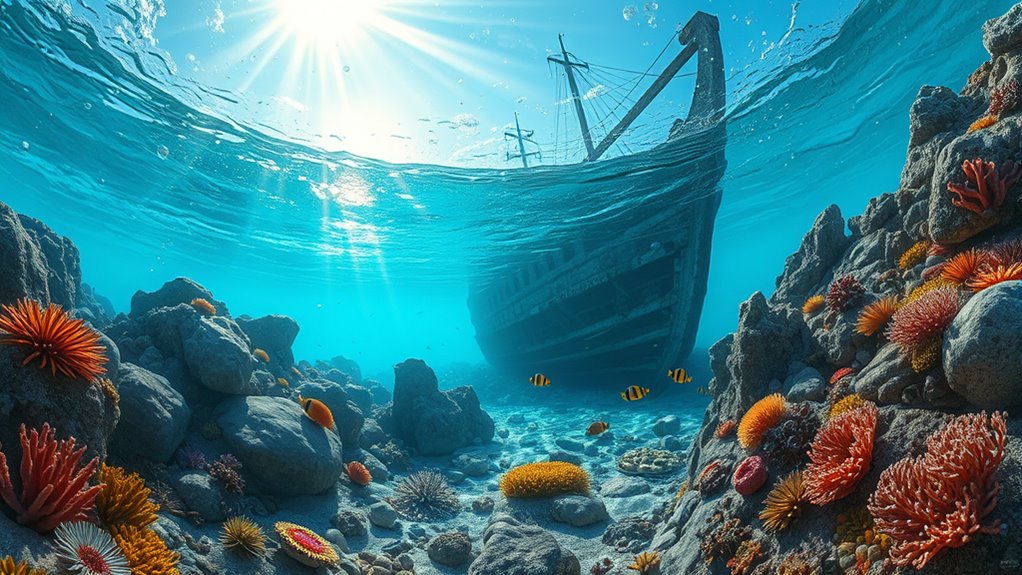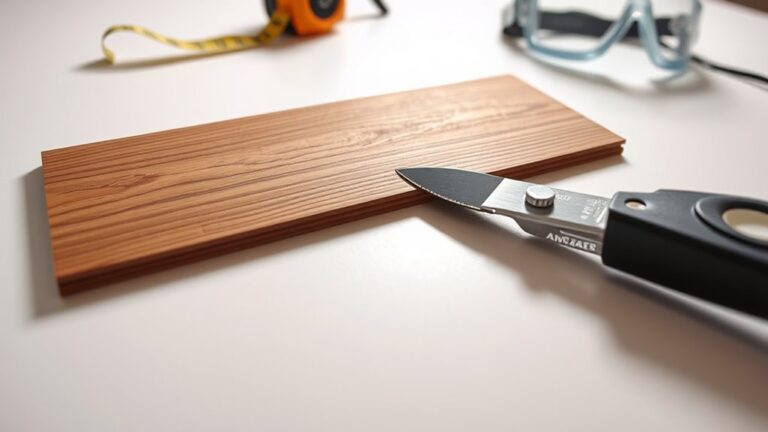Beneath the ocean floor, you’d find layered basaltic crust topped by varied sediments, ranging from terrigenous particles near continents to biogenic deposits in open ocean. Below lies a sheeted dike complex and coarse-grained gabbro, forming the oceanic crust, underlain by dense mantle peridotite of the lithosphere. Tectonic activity shapes trenches, ridges, and subduction zones, while hydrothermal vents foster unique ecosystems. These structures record Earth’s dynamic geological and ecological history, offering much to uncover about our planet’s inner workings.
Composition of Oceanic Crust
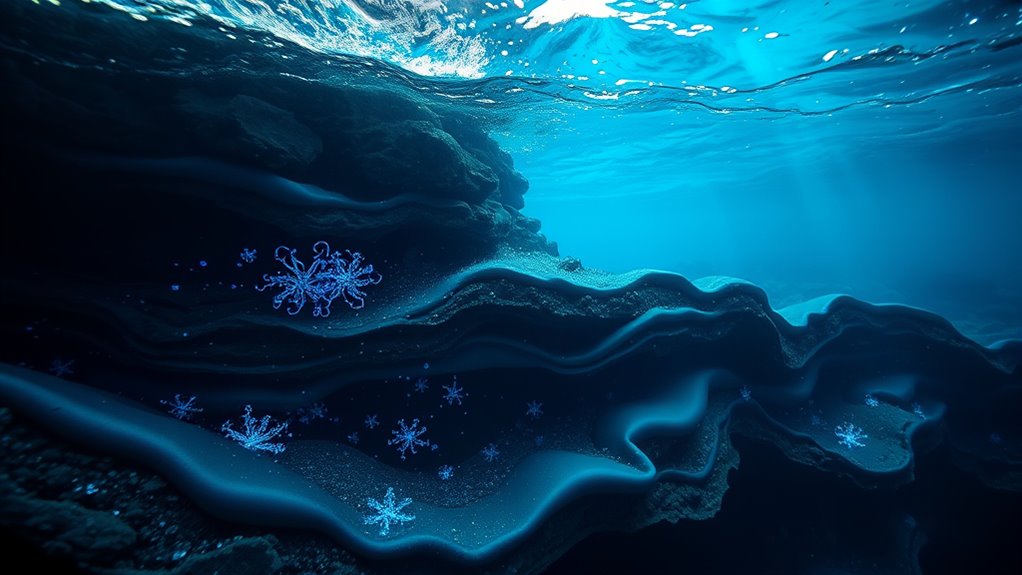
The oceanic crust primarily consists of three layers, each with distinct compositions and properties that influence tectonic activity and seafloor morphology. When you examine the oceanic crust, you’ll find the uppermost layer is mainly basaltic lavas, rich in minerals like plagioclase feldspar and pyroxene. Beneath that, the sheeted dike complex acts as a conduit for magma, characterized by fine-grained gabbro with similar mineral composition but differing textures. The lowest layer consists of coarse-grained gabbro, a slow-cooled intrusive rock with an increased presence of olivine and clinopyroxene. This stratification in mineral composition dictates the crust’s physical strength and density variations, impacting seafloor spreading rates and subduction behavior. Understanding these layers helps you appreciate how the oceanic crust dynamically interacts with the underlying mantle and tectonic forces.
Layers of Sediment on the Seafloor
You’ll find that sediment on the seafloor varies notably in composition, ranging from terrigenous particles to biogenic remains and volcanic ash. The thickness of these sediment layers isn’t uniform either; it depends largely on factors like proximity to continental margins and oceanic productivity. Understanding these variations is essential for interpreting geological processes and past environmental conditions.
Sediment Composition Types
Sediment composition on the seafloor varies considerably, reflecting a complex interplay of biological, chemical, and physical processes. When you examine sediment types, you’ll find terrigenous sediments derived from continental erosion, biogenous sediments composed of skeletal remains, hydrogenous sediments precipitated directly from seawater, and cosmogenous sediments from extraterrestrial sources. Sediment distribution is heavily influenced by proximity to land, ocean currents, and biological productivity. Near continental margins, terrigenous sediments dominate due to riverine input, while biogenous oozes prevail in open ocean basins where productivity is high. Hydrogenous sediments form in localized areas with specific chemical conditions, such as manganese nodules. Understanding these sediment types and their distribution helps you interpret past environmental conditions and geological processes shaping the ocean floor’s stratigraphy with precision and scientific rigor.
Sediment Thickness Variation
Although sediment accumulation rates vary widely across the ocean vloer, you’ll notice that sediment thickness generally increases with distance from mid-ocean ridges and proximity to continental margins. Near ridges, rapid crustal formation limits sediment buildup, while farther away, prolonged sediment transport and deposition allow thicker layers to form. Sediment compaction plays a critical role, as overlying weight compresses deeper sediments, reducing porosity and altering thickness measurements. Transport mechanisms, including turbidity currents and pelagic settling, influence sediment distribution patterns, concentrating materials near continental shelves and abyssal plains. By analyzing these variations, you gain insight into geological processes shaping the seafloor. Understanding sediment thickness and its controls not only reveals the ocean’s dynamic history but also guides exploration of subsurface resources and environmental conditions beneath the ocean floor.
Structure of the Oceanic Lithosphere
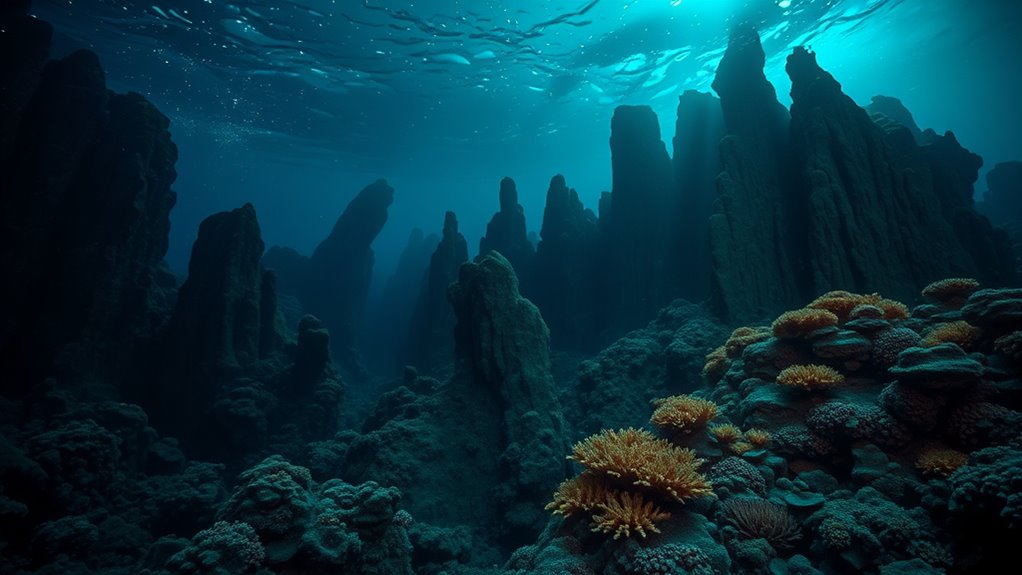
Beneath the ocean floor lies the oceanic lithosphere, a rigid layer composed of the uppermost mantle and the overlying basaltic crust. When you analyze its structure, oceanic mineralogy plays a significant role; the crust primarily consists of basalt and gabbro, rich in iron and magnesium silicates. This mineral composition directly influences seismic wave propagation, as waves travel faster through denser mantle peridotite than through the basaltic crust. The lithosphere’s thickness varies with age, thickening as it cools and moves away from mid-ocean ridges. Understanding this layered structure helps you grasp how tectonic plates interact and how the oceanic lithosphere contributes to Earth’s dynamic system. Your exploration of this rigid shell reveals a complex interplay between composition, temperature, and mechanical properties beneath the seafloor.
Ocean Trenches and Their Formation
You’re about to explore how ocean trenches form through the interaction of tectonic plate movements, where one plate subducts beneath another, creating deep, narrow depressions. You’ll analyze how accumulated sediment layers influence trench morphology and stability over time. Additionally, volcanic activity adjacent to these zones plays an essential role in modifying trench structures and associated geological processes.
Tectonic Plate Movements
When tectonic plates converge, the denser oceanic plate is forced beneath the lighter continental or oceanic plate in a process called subduction, which creates deep ocean trenches. This movement is most intense at plate boundaries, where the interaction causes significant seismic activity. You’ll notice that:
- Ocean trenches mark zones where subduction is ongoing, forming narrow, elongated depressions.
- The descending plate melts into the mantle, influencing volcanic activity and crust recycling.
- Seismic activity here is frequent and powerful, often triggering earthquakes and tsunamis.
Understanding these dynamics gives you insight into the ocean floor’s continual reshaping. The freedom to explore these processes reveals the ocean trenches not just as static features, but as active zones where Earth’s lithosphere is constantly in motion, driven by plate tectonics at various boundaries.
Sediment Layers Accumulation
Although ocean trenches are primarily formed by tectonic subduction, their distinct morphology is also shaped by the continuous accumulation of sediment layers. You’ll find that sediment transport plays an essential role, delivering fine particles from continental margins and abyssal plains into these deep depressions. This influx modifies trench topography, gradually filling depressions and altering slope gradients. Additionally, bioturbation effects caused by benthic organisms disrupt sediment stratification, enhancing porosity and influencing geochemical gradients. These biological processes accelerate sediment mixing, impacting compaction rates and sediment stability. Understanding this dynamic interplay between sediment deposition and bioturbation helps you appreciate how trenches evolve over geological timescales, balancing tectonic shaping with sedimentary processes. So, while subduction drives trench formation, sediment accumulation and biological activity intricately refine their structure beneath the ocean floor.
Volcanic Activity Influence
Beyond sediment dynamics, volcanic activity greatly impacts the formation and evolution of ocean trenches. As you explore these deep-sea features, you’ll notice volcanic eruptions contribute directly to trench morphology by altering the crust’s structure. Magma formation beneath tectonic plates initiates subduction processes, driving trench development.
Consider these key influences:
- Volcanic eruptions inject new material, reshaping trench walls and affecting sediment distribution.
- Magma formation zones generate thermal anomalies, weakening lithosphere rigidity and facilitating trench deepening.
- Interaction between descending slabs and magma chambers influences trench curvature and seismicity.
Mid-Ocean Ridges and Underwater Mountains
Because mid-ocean ridges form the longest mountain ranges on Earth, you might not realize they’re mostly hidden beneath the ocean’s surface. These underwater geological features extend continuously for over 65,000 kilometers, marking divergent tectonic plate boundaries where magma rises and creates new crust. The ridge system shapes mid ocean ecosystems by influencing hydrothermal circulation and sediment deposition patterns. As you explore these ridges, you’ll notice their complex topography includes axial valleys, fault zones, and volcanic peaks, all sculpted by seafloor spreading processes. Understanding their morphology and formation provides insight into plate tectonics and oceanic crust renewal. These underwater mountains are critical to ocean structure, impacting ocean currents and biological habitats, exemplifying how dynamic geologic forces beneath the sea floor sustain diverse ecosystems and contribute to Earth’s geological evolution.
Hydrothermal Vents and Their Ecosystems
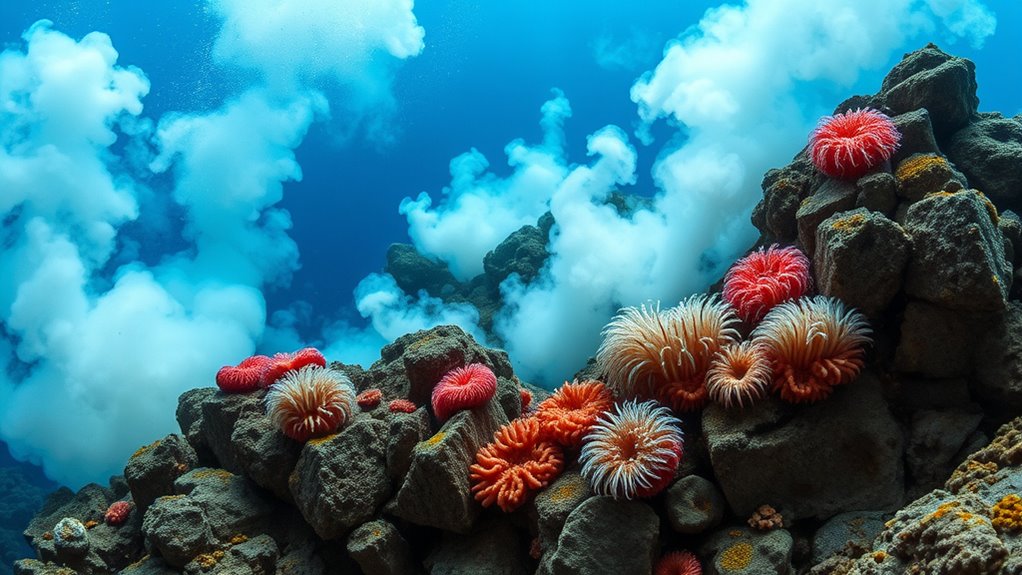
When tectonic plates diverge along mid-ocean ridges, hydrothermal vents form as seawater seeps into the crust, heats up, and rises back through fissures, carrying dissolved minerals. You’ll find that hydrothermal ecosystems thrive in these extreme, mineral-rich environments, despite the absence of sunlight. Vent organisms rely on chemosynthesis, where bacteria convert chemicals from vent fluids into energy, forming the base of the food web. Key aspects of these ecosystems include:
Hydrothermal vents host unique ecosystems powered by chemosynthesis, thriving in extreme, sunless ocean depths.
- Specialized vent organisms such as tube worms, clams, and shrimp, uniquely adapted to high temperatures and toxic chemicals
- Rapid nutrient cycling driven by microbial communities that sustain higher trophic levels
- Dynamic environmental gradients creating diverse microhabitats, fostering biodiversity unseen elsewhere on the ocean floor
Subduction Zones and Plate Tectonics
Although hydrothermal vents showcase the dynamic processes at divergent boundaries, subduction zones represent a contrasting tectonic setting where one plate is forced beneath another. You’ll find that subduction processes drive the recycling of oceanic lithosphere, creating deep ocean trenches and triggering intense tectonic interactions. As the descending plate sinks into the mantle, it induces melting that forms volcanic arcs and fuels seismic activity. Understanding these interactions reveals how energy and materials cycle between Earth’s surface and interior. This mechanism not only shapes oceanic topography but also influences global geodynamics. By examining subduction zones, you gain insight into the forces sculpting our planet’s crust beneath the ocean floor, illustrating the relentless and complex nature of plate tectonics that governs Earth’s evolving landscape.
Geological History Recorded Beneath the Ocean Floor
If you want to understand Earth’s past environments and tectonic movements, the ocean floor offers an exceptional geological archive. Sediments and rock layers beneath the seafloor record vast spans of geological time, preserving clues about ancient environments and climatic shifts. By studying these strata, you can reconstruct Earth’s dynamic history with precision.
Key insights include:
- Sediment cores revealing fluctuations in ocean chemistry and temperature over millions of years.
- Magnetic anomalies in basaltic crust documenting seafloor spreading and plate motions.
- Fossilized micro-organisms embedded in layers, marking evolutionary and environmental changes.
This detailed record beneath the ocean floor allows you to analyze how tectonic forces shaped continents and oceans, providing a thorough timeline of Earth’s geological evolution.

